PenInHand - Musings on the Hobby
The Path To Conversion
by Jim Mamoulides, July 4, 2005
When Sheaffer introduced the Fineline cartridge pen in 1955 it started a quiet revolution that changed fountain pen designs as dramatically as the lever did in 1913. Up until the introduction of easy to use and low cost ink cartridges, all fountain pens were bottle fillers of some type and the only portable ink supply would be a glass bottle carried with you on your business. As Sheaffer's lever fill system helped in the transition to the golden age of self-filling fountain pens, the Sheaffer Skrip disposable ink cartridge would help usher in the modern era of cartridge / converter pens.
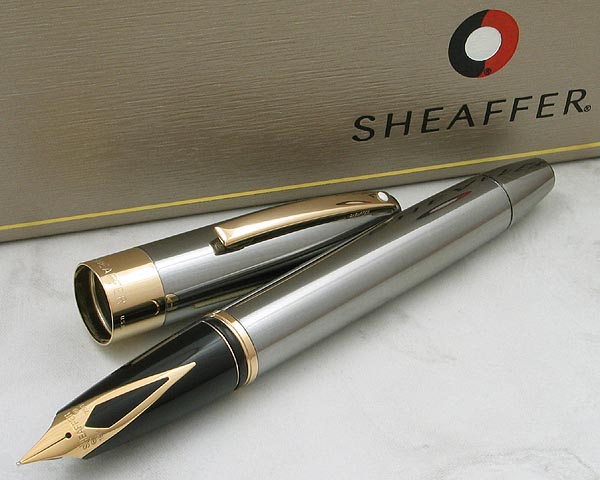
Not Everyone Thinks
Of The Sheaffer Legacy 2 As A Cartridge / Converter Pen - But It
Is
As with self-filling pens, Sheaffer was not first to market with a cartridge pen. The title of earliest widely successful self filling pen would probably go to Conklin for the Crescent Filler, introduced in 1898. Though the Sheaffer lever filler arrived some fifteen years later, the notion of a filling system that remained flush to the barrel when not in use was so simple and compelling that all the major pen companies eventually reverse engineered their own version of the system.
Cartridge pens may seem like a modern idea, especially since the majority of modern pens use a removable cartridge system, the earliest successful cartridge pen would likely be the Eagle Pencil Company glass cartridge pens, introduced in the 1890s. And though there would be other attempts to make cartridge pens, it would be the 1950s before the cartridge would really take off.
Cartridges may be convenient, but the cost per volume of ink was vastly higher than with bottled ink, so many users wanted it both ways.
The interesting thing about Sheaffer converters is that Sheaffer tried almost every type of converter filling system that has been used. Except as noted, all of the converters that follow will fit any Sheaffer pen that takes standard Skrip cartridges.
Plunge In!
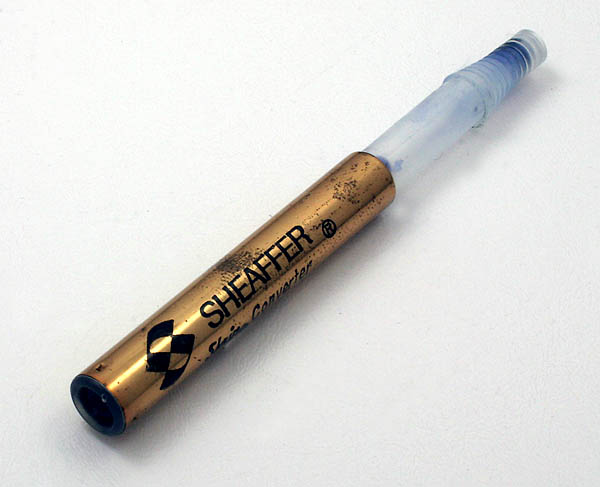
The Earliest Sheaffer Converter - The
Skrip Converter c1964
The introduction of the Lifetime pens in 1963 marked the first time in Sheaffer history that the top models offered would be cartridge only pens. It's not clear why, but Sheaffer very quickly introduced a plunger type converter to allow the new pens to be filled from a bottle. My guess is that Sheaffer couldn't quite convince everyone that cartridges were the way to go, regardless of how convenient, so a converter was needed.
The first Sheaffer converter was a very compact plunger filler. Because of the interior design of Sheaffer cartridge pens, which had stops in the barrel for Sheaffer Skrip cartridges, and very little room past the stop, the design of any converter had to make use of this space. With the plunger in the down position, the converter is barely bigger than a Skrip cartridge and the tapered handle fits into the tiny space most Sheaffer cartridge models at that time had in the base of the barrel.
This is a relatively uncommon converter to find and they are often in non-working condition. The most common problem is the soft plastic plunger tears from use, making it unable to create the downforce to expel air to fill. The principal of the plunger filler converter is not unlike the Dunn or Sager plunger fill pens of the 1920s.
The plunger converter works by repeated downstrokes of the plunger unit until the pen fills. The plunger unit is clear so the ink level can be seen as the converter fills and the handle will show with level with the plunger inside the converter. It's essentially the same action as a bulb filler, where with each downstroke, air rushes out of the feed and more ink is sucked in until the ink chamber is full.
Push My Button
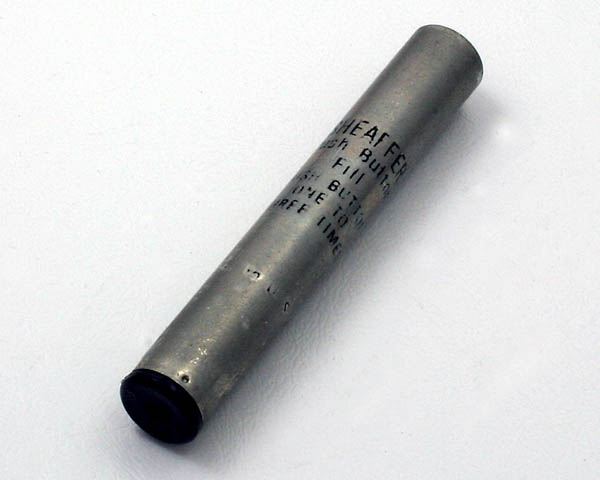
The Button Fill Sheaffer Converter c1966
The second converter Sheaffer tried is a steal out of the Parker playbook. The button converter works by pressing the button on top, which activates a spring bar inside the barrel that collapses the ink sac. This method is basically how Parker Duofolds from the 1920s work. It's notable, that as with the plunger type, the button converter is very compact, allowing it for use in pens designed as cartridge only.
The button converter was not the most efficient unit and probably was only in production from about 1966-1968, timed alongside the Stylist pen line, and may often be found in those pens. Many of these are found in the wild with sprung buttons, mashed caps, or are otherwise non working.
The Sheaffer button converter fills by pressing the button up to three times and waiting for the sac to fill.
Sheaffer's Got A Squeeze Box
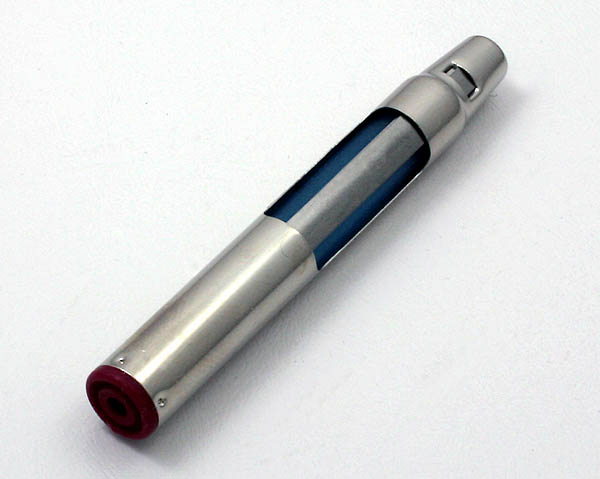
The Sheaffer Classic Converter - Used From
The Late 1960s Through The 1990s
The converter with the longest run to date is the Sheaffer Classic converter, still available at this writing, but not issued with any new Sheaffer models. Sheaffer probably stopped putting them in as original equipment by 1997. Introduced probably as early as 1969, the Classic converter is a straightforward press-bar unit that works by directly squeezing the sac, much like the action of a bulb filler. Often misidentified as an aerometric converter, there is no breather tube in this converter.
The Classic converter fills by repeated pressing the bar until the ink level can be seen through the sac near the top of the sac. With each squeeze, air rushes out of the feed and more ink is sucked in until the sac is full.
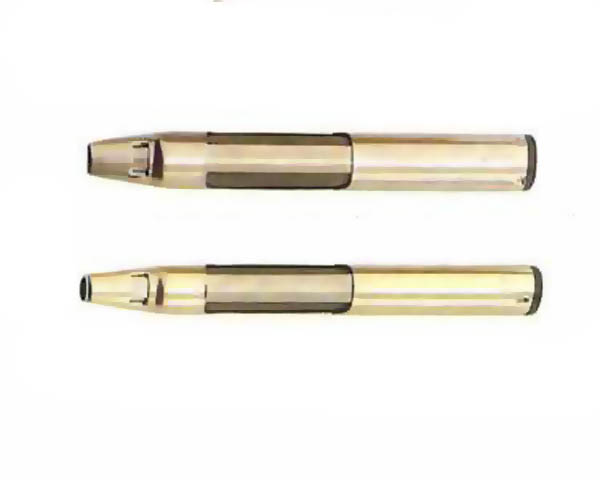
The Sheaffer Classic Converter (Top) With
The Slim Converter (Bottom)
When Sheaffer introduced the TRZ in 1981 and the Slim Targa in 1982, a new converter needed to be made for the narrower barrel. Sheaffer resized the Classic converter to fit. This slim converter is the only non-standard size Sheaffer converter.
Touchdown Sheaffer
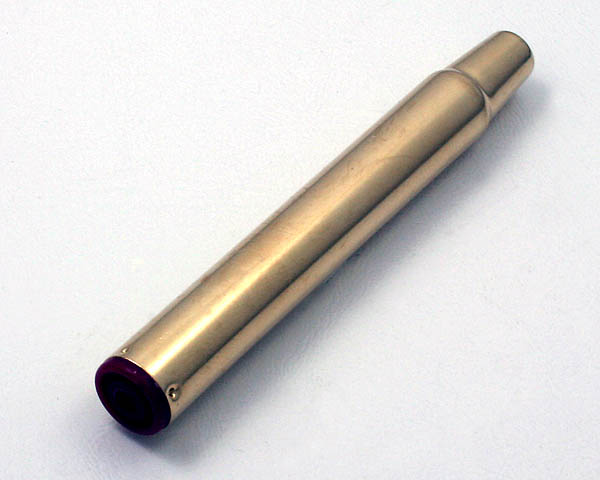
The Sheaffer Legacy / Legacy
2 Touchdown Converter - 1995-2003
When Sheaffer revived the Touchdown pen in 1995, they created a unique version of the filling system that allowed the pen to be both a Touchdown bottle filler and a cartridge filler. This new system allowed Sheaffer to revive the look and feel of the legendary PFM and still make the pen approachable as a cartridge pen.
The converter is essentially a gold plated version of the Classic converter, with a more pliable sac that allowed the pneumatic Touchdown system to compress for filling. Because the system is not as completely sealed as the original Touchdown pens, it takes two strokes to fill. Early converters had more rigid sacs, a problem that Sheaffer corrected in later models.
This is the only converter that is not directly manipulated to make it fill with ink. In essence, it is a sac holder, and the Touchdown plunger creates the pneumatic force that collapses the sac, and the action of the sac expanding back into the vacuum created in the barrel is what fills it.
Turn, Turn, Turn
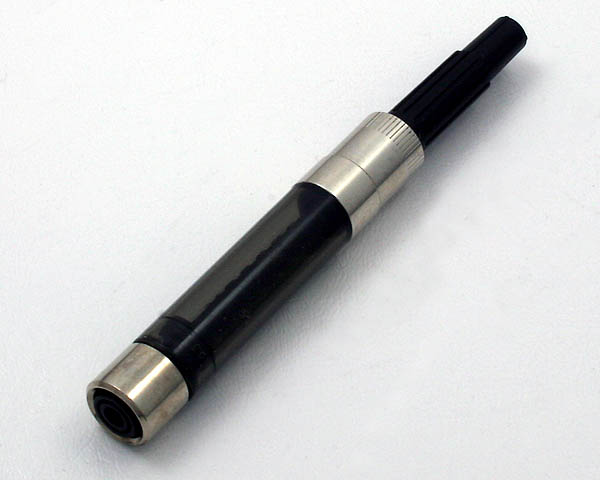
The Sheaffer Piston Converter - Current
Model
It took all the way into the late 1990s for Sheaffer to get with the rest of the pen world and start using piston converters. There's nothing exceptionally exotic about piston systems, but Sheaffer resisted. The earliest piston fill pens date from the early 1930s, including the Pelikan 100 and the Conklin Nozac. The original converter issued with the Parker 45 in 1960 was a piston unit. It appears that Sheaffer embraced the piston world in 1998, the same year as the introduction of the Balance II.
The piston converter works much like a syringe, sucking the ink into the chamber as the piston pulls upward, and expelling ink as the piston is moved downward.
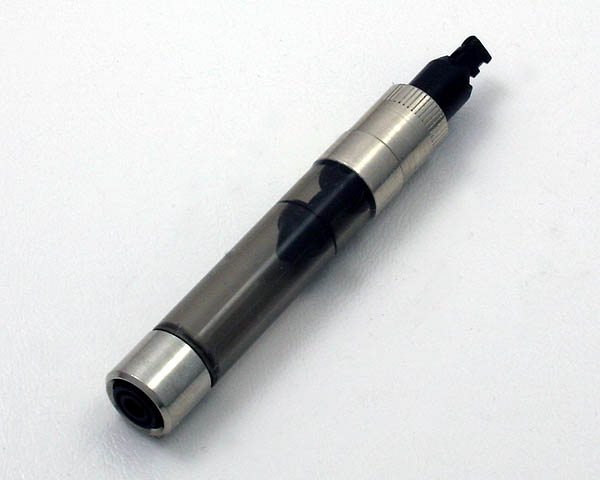
The Sheaffer Intrigue
Piston Converter - 2000-2004
Of course, Sheaffer has never been content to merely be like everyone else, especially when it comes to filling systems. When the Intrigue was introduced in 2000, it included a unique cartridge / converter system that allowed the pen to be bottle filled without opening the pen, much as any other non-cartridge piston filling pen. To make this work, Sheaffer redesigned the piston converter with a toothed cap that meshed with teeth in the end of the barrel and was operated by twisting a button on the barrel end. This unique system allowed the Intrigue to function as both a cartridge pen or as a converter pen, and allowed for filling without opening the pen.
Next time, we explore the most successful cartridge of all time, and discover that in spite of that, Sheaffer still tried new ideas for cartridges since they were first introduced in 1955.
Discuss / Recommend what you read on PenHero.com
Follow us on Twitter: PenHero
Add a link to PenHero.com on your blog:
(Copy & paste code)
Please only use the photo provided. Use of other photos requires permission.
The provided link photo will change as we update the site.
Comments on this article may be sent
to the author, Jim Mamoulides
PenHero.com Bibliography
